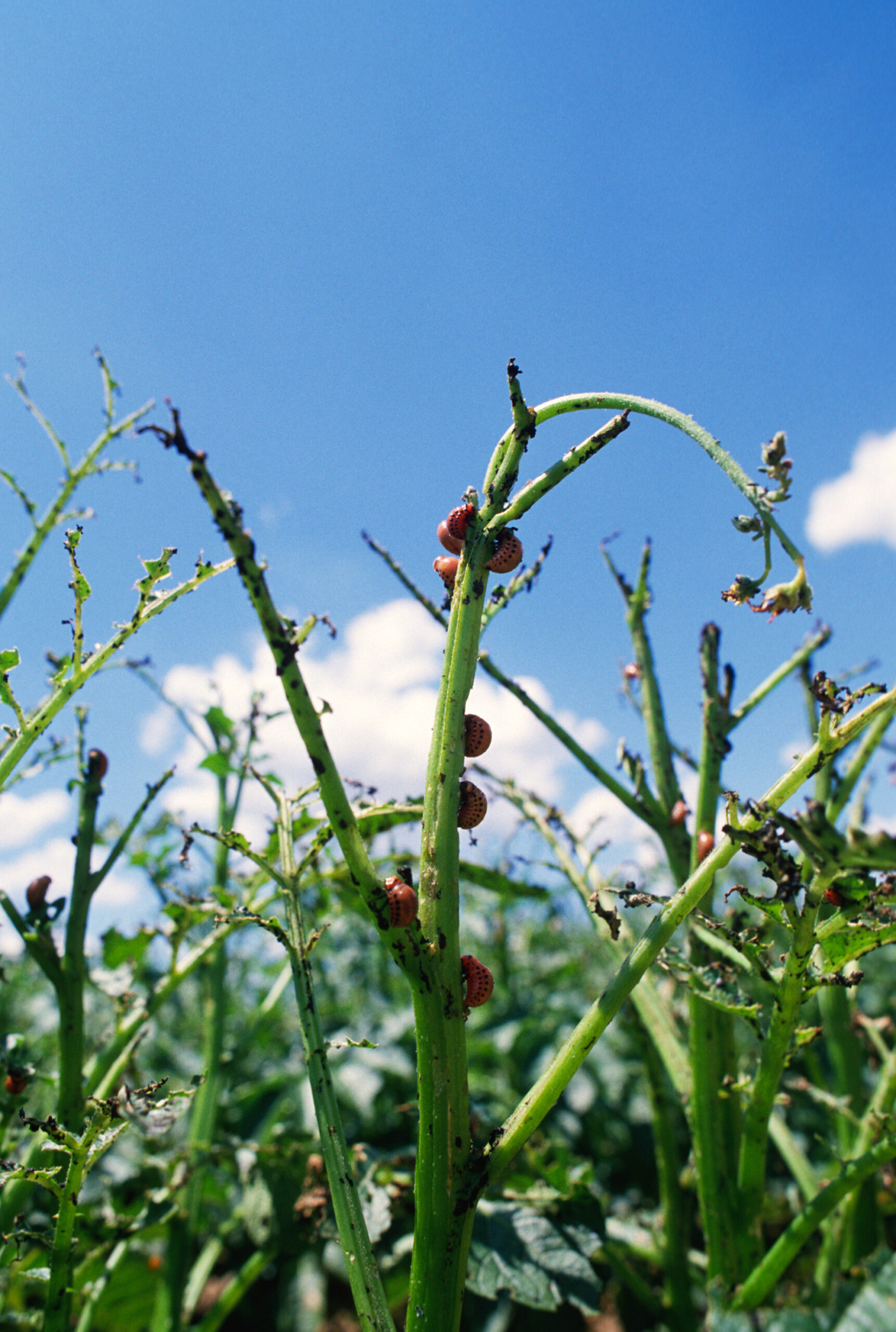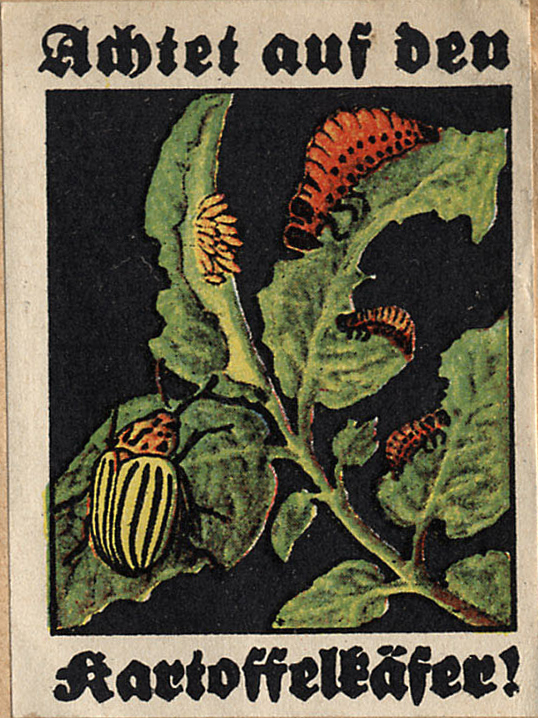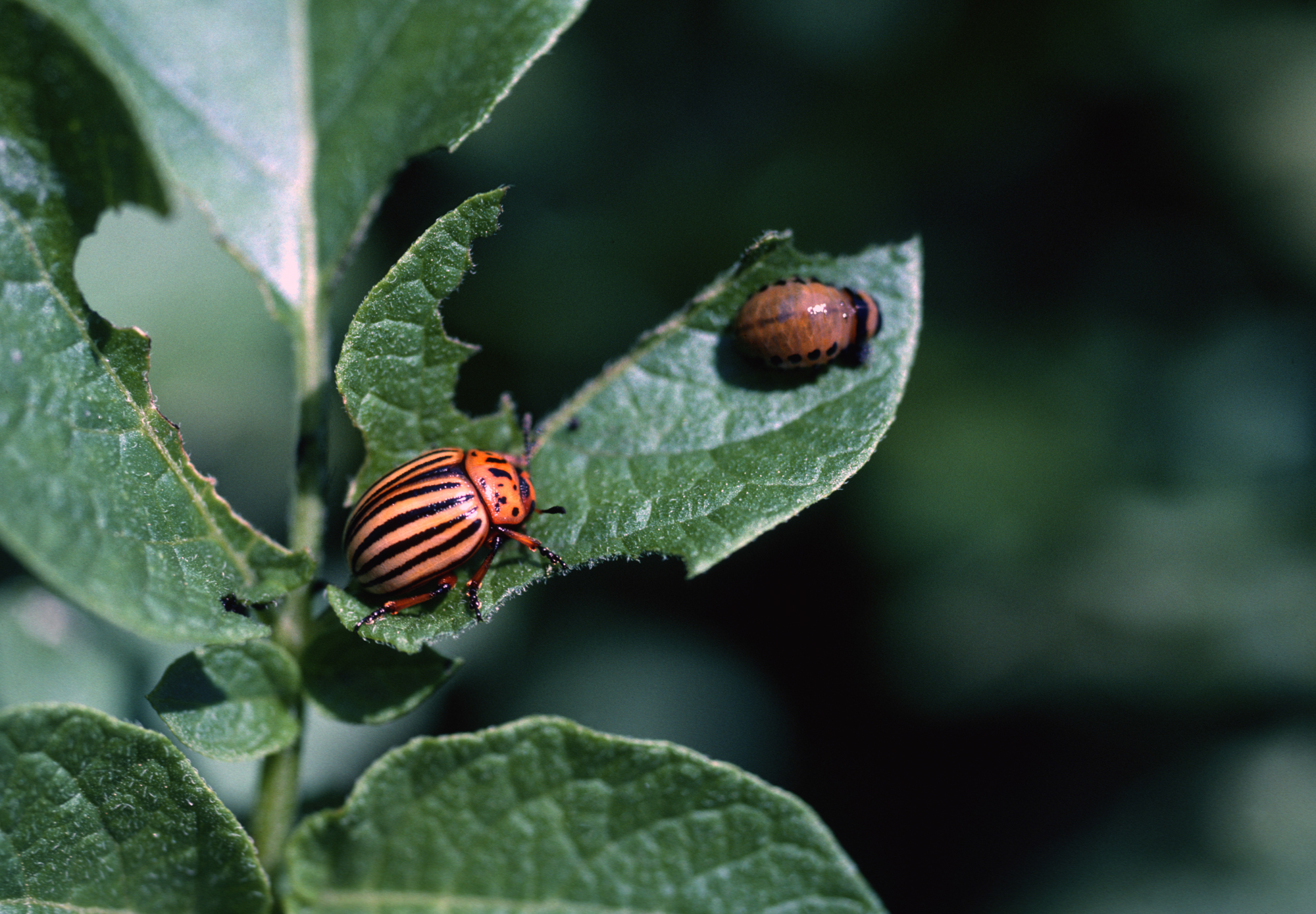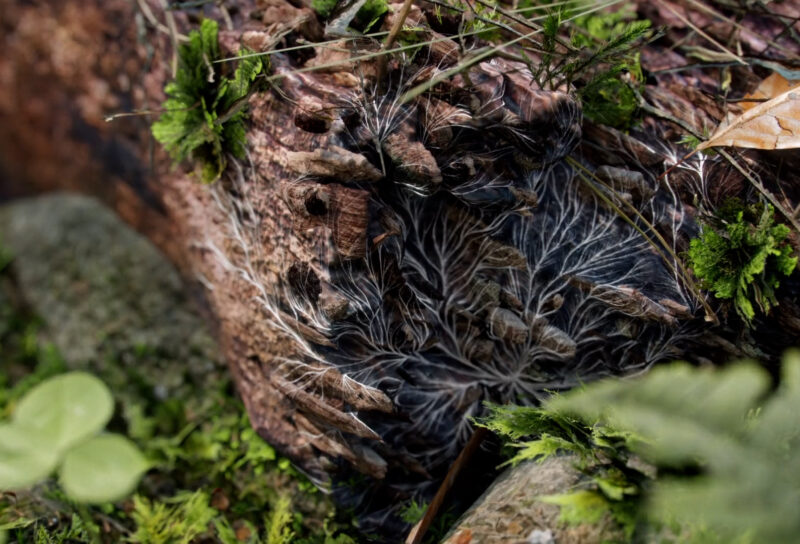“Let the wise place no confidence in such predictions, for the predictors can have but a vague conception of the grand scheme of Nature, and of the laws which govern both animal and vegetable life.” – Charles V. Riley, Missouri state entomologist, in an 1869 report to the state legislature.
In 1994, Andrei Alyokhin witnessed a miracle in a potato field. Alyokhin, then an entomology graduate student at the University of Massachusetts, was testing imidacloprid, a new form of chemical pesticide that resembles nicotine. “I remember seeing a plant which was completely undamaged. And there was a circle of dead beetles around it,” he says.
These were Colorado potato beetles, perhaps the most notorious agricultural pest on the planet. They are tiny, less than half an inch in length, pale yellow, lined end-to-end with ten black stripes. Females lay hundreds of eggs per season in bright orange clusters that line the underside of leaves. Left unchecked, they eat whole plants—leaf, stem, and tuber. Every year, they chew through billions of dollars in lost crop and preventive actions. Entomologists refer to them as a superpest.
In the early 1990s, deliverance from the potato beetle seemed to arrive, in the form of imidacloprid. The potato plant absorbed it, so rain wouldn’t wash it off, and it didn’t harm mammals. Most importantly: it worked. Imidacloprid killed the potato beetle at a moment when the pest had rendered every single pesticide on the market essentially useless. Imidacloprid seemed like an incredible breakthrough. Until it didn’t.
Three planting seasons after Alyokhin’s miracle in Massachusetts, the honeymoon was over. Beetles exposed to it started developing resistance to imidacloprid.
Alyokhin is one of the leading observers of a global, century-plus conflict. Like a millennia-long relationship between a predator and prey—beetle and human—it could be called an evolutionary arms race. And the beetles are lapping everyone.
They continue to dodge every preventative measure farmers attempt. When farmers rotate crops, beetles burrow into the soil and stay dormant for years until the potato comes back around. They can fly for kilometers in search of food and mates, encountering more and more potato fields. Female beetles fertilize themselves with sperm saved from previous seasons. By distributing offspring through space (within and between fields) and time (within and between planting years) they lose fewer offspring to insecticide or crop rotation. Different populations around the world develop different kinds of pesticide resistance. Some pesticides that work in one place won’t work in another, adding an element of trial and error. In dire straits, potato beetles will cannibalize each other to survive.
In the face of its most persistent pest, more and more farmers are turning away from classical pesticides. The most enterprising in the industry have started to borrow from the newest tools in medicine.
Genetic engineers treat evasive tumors by targeting the cancers’ specific DNA; they find a cancer cell’s specific weaknesses by sampling and sequencing; they exploit those weaknesses in ways that chemical-based drugs could never achieve. The key to this tailored and agile treatment is RNA. It gives doctors a route to precisely target cancer cells without accidentally killing normal cells in the process. Agriculturalists hope to treat the beetle like a tumor in the potato field. It may soon be possible to eschew chemical pesticides, and instead kill the beetle with a rain of RNA.
Nature’s poisons
Spanish colonialists met Solanum tuberosum, the now-common white potato, in the early 16th century, in what is now Peru. They sent it back to Spain; it circulated around Europe, reaching England and the British Isles in 1580, where it was overwhelmingly rejected. 16th century Brits thought it was as poisonous as other nightshades, like mandrake and datura.
The potato migrated back across the Atlantic to Britain’s North American colonies in 1613, a scant few decades after it had reached Europe. It advanced westward across the continent, reaching the Colorado potato beetles’ western US territory in the early 19th century.
For about 30 years, not much happened. But before long, reports emerged of beetles spreading furiously. In 1859, potato beetles destroyed potato crops 100 miles west of Omaha. They crossed the Mississippi River in 1865. Soon, people spoke of the Colorado potato beetle like the invasion of a dread army.
“By the autumn of 1866, the Colorado Potato-beetle, which appears to have invaded the south-west corner of Wisconsin at as early a date as 1862, had already occupied and possessed a large part of the cultivated or southern parts of that State,” Missouri’s state entomologist Charles V. Riley reported to the legislature in 1869. “And in Illinois if we draw a straight line to connect Chicago with St. Louis, nearly all the region that lies to the north-west of that line was overrun by it.”
Potato beetles proved to have an insatiable taste for nightshades. Up until 200 years ago, it fed peacefully on a potato relative in the nightshade family, the Buffalo bur (Solanum rostratum)—a plant itself brimming with toxic alkaloids.
“Nature is full of poisons,” Alyokhin says. “It’s full of various malignancies, full of all kinds of genetic stuff that’s trying to get you. Viruses. Transposable elements.”
The beetles reached Ohio in 1869. England in 1875. France, 1922, and wherever they went, a defenseless plant got thoroughly routed. Besides nightshades, they developed an appetite for eggplants, tobacco, tomatoes, and peppers.
By the 20th century, the potato had become a worldwide staple crop. The beetle had so much food, and farmers so few defenses, that rumors swirled of beetles so numerous that the piles of dead bugs at the end of a season could derail a moving train. That’s an exaggeration, of course, but not by much: the potato beetle produces two generations per growing season, and each female produces 300-800 eggs all on its own. As they crossed Europe in the mid-20th century, Cold War governments suggested that decimated potato crops were deliberate acts of biological warfare.
Even the details of the beetles’ life history has helped them cover the world. Organisms usually hit a genetic bottleneck when their environment changes (like, say, an insect meeting an unfamiliar plant to feed on). They’ll die off en masse until a founder generation establishes a foothold, its next generations a bit more fragile thanks to the narrower gene pool. Not the potato beetle.
The potato was introduced to the beetle’s native habitat, not the other way around. And the newcomers were so similar to beetle’s native diethost, the Buffalo bur, that the beetle lost none of its vigor in switching from its native host to its new one.
Resistance is nature’s reaction to poison. Bacteria become resistant through supersonic reproduction and the free and easy trading of genes with each other. Plants resist herbicides in a variety of ways thanks to comically plastic genetics that can absorb mutations like a spray of buckshot.
The potato beetle’s resistance stands out among insects and animals. It evolved to feed safely on a poisonous nightshade. So as the beetle amassed strength against those natural plant defenses, it seems genetically primed to respond to newly created ones too. So primed, the potato beetle marched westward methodically, crossing the globe wherever the worldwide spread of potatoes took it. The movements of an itinerant scientist are more happenstance.

Crossing paths
Alyokhin was drafted into agriculture as a college student from Moscow, and was sent to a collective farm in the Soviet Union. “I was not,” he emphasizes, “sent to collect bugs.” The Colorado potato beetle had been a pest there for decades, with the first infestation discovered in Lviv, Ukraine, in 1937. The USSR had accused the United States of airdropping beetles over the Soviet states and East Germany. “They didn’t have seasonal agricultural workers back then in the USSR. So instead they used students or conscripted soldiers.”
“We were sent to pick up beets, which was actually quite a bit of fun, though harvesting cabbage was one of my favorite jobs. Physical labor, fresh air. It helped direct me into agriculture,” he continues. “I just showed up at the entomology department and said I’m ready to volunteer. They gave me projects on millipedes and ground beetles.”
Alyokhin crossed the globe after college, returned to Russia, then went to Massachusetts to study pesticide resistance in the Colorado potato beetle. His thesis described beetle resistance to Bt-toxin, a pesticide commonly genetically engineered directly into crop plants so they naturally express it. Nearly every corn plant in the US carries Bt-toxin, and Monsanto sold a Bt-potato variety from 1995 to 2000. The company withdrew it from the market due to consumer pushback to GMOs.
After finishing his PhD, Alyokhin had a decision to make. He weighed job offers from the University of Hawai’i, and Cornell University in upstate New York. As a child in Moscow, he had read books on far-flung scientific derring-do by Jane Goodall and Diane Fossey. That kid in him sought to create his own adventure. Upstate New York didn’t seem change enough, compared to Massachusetts: “I would have betrayed that boy,” he said. He chose Hawai’i.
White plantation owners were introduced to Hawai’i in the early 19th century, and thereafter, the archipelago became a biocontrol laboratory — with the plantation owners importing one life form to control another. These included bringing the small Indian mongoose to eat rats, or coincidentally, bringing in white Russian farm workers to break Asian labor strength. “For a while, in people’s minds, it was ‘chemicals bad, biocontrol good,’” Alyokhin said. Hawai’i in the late 1990s and early 2000s was “the peak of the brouhaha around biocontrol” of pests.”
The mongooses worked extremely well, discounting that, aside from rats, they hunted nearly every native bird species in Hawai’i to criticality. The Russian farm workers left after six months, and research on the mongooses introduced around Alyokhin’s time prompted a reevaluation of the concept of introducing a species for pest control. “People who worked in biocontrol felt really offended because they considered themselves to be on the good side of history,” Alyokhin recalls.
The evidence of its devastation speaks for itself: managing any pest—rats or potato beetles or crabgrass or rabbits or anything else—through biocontrol is an old, colonialist idea. It’s a static, destructive, loose-cannon, environment-wide approach to address a fluid and evolving problem. Something better, more elegant, more sustainable, would evolve too.
Hoping for a new miracle
Legend has it that some time in the late 19th or early 20th century, a loose drop of green copper arsenite paint killed a Colorado potato beetle, and the modern pesticide industry was born. Soon after, hand-pumps and horse-drawn sprayers carried green paint to cover the fields. Then came lead arsenite, Bordeaux mixture (copper sulfate plus lime), DDT, aldrin, and heptachlor. By the time the potato beetles reached all the way to China in the 1990s, Aloykhin was studying resistance to Bt-toxins, thiamethoxam, and the maybe-miraculous imidacloprid. The vast majority of insecticides are neurotoxins, including DDT and imidacloprid. Many target a single pathway: the acetylcholine pathway, which connects neurons to muscles. They overload neuronal connections until they short-circuit, resulting in a characteristic twitching dead insect. Their lethality doesn’t matter; in total the Colorado potato beetle has varying levels of resistance to 56 different pesticides.
In 2006, a new door opened that brought more pathways into play. Biologists Andrew Fire and Craig Mello won the Nobel Prize for discovering RNA interference, or RNAi. They discovered a remarkable system where cells use small RNA pieces as a guide to target and destroy a messenger RNA with a matching sequence, all but eliminating that gene. This system defends cells against viral, bacterial, and fungal infections all over the tree of life.
If someone were to pick just the right gene that was critical to the survival of a unique pest, create an RNA to turn it off, and, say, spray it on a field of potatoes, that pest might just drop dead.
There are only a few human medicines that use RNAi, all for treating exceptionally rare metabolic disorders. But RNAi is similar in spirit to the most successful feat of genetic engineering, chimeric antigen receptor T-cells (CAR-T). CAR-T is a bit more laborious, since it requires removing a small subset of cells from a patient, manipulating them separately and then reinfusing them. But the change in viewpoint is the same: instead of allowing humans to master disease and pestilence, all forms of genetic engineering, RNAi or CAR-T or a thousand other forms, have given us new targets to attack that we could not before. They are all a rapid, alterable, and scalable version of all our old elixirs.
That’s not nothing. RNA is extremely easy to customize and synthesize in a lab. So potato beetles’ adaptability makes them a tempting prospect for RNAi. Instead of being restricted to a single pathway in a single nervous system, RNAi hypothetically makes every biological pathway a target.
Alyokhin, as part of his responsibilities as a professor at the University of Maine, tests pesticides, comparing low tech treatments like mineral oil, and commercial pesticides with macho, chest-pounding names like Besiege and Activator. RNAi has entered his slate. He’s testing Calantha, from Massachusetts-based biotech company Greenlight Bioscience, an RNAi formulation that targets the Colorado potato beetle. Technical details of Calantha are still under wraps (Greenlight declined an interview request), but it’s the culmination of years of tinkering and dithering.

The RNA sequence Alyokhin is testing in the fields of Maine targets the potato beetle’s proteasome, the cellular complex that degrades and recycles unneeded, misfolded, or dangerous proteins. Blocking one of the proteasome’s essential proteins (in this case the proteasome 20S subunit beta 5) destroys the whole complex, causing a poisonous build-up of proteins. Detritus piles up in the beetle’s cells until it dies. Researchers have suggested RNAi to fight organisms as far afield as wine grape-destroying gray molds, aphids, and Aedes aegypti, the yellow fever mosquito.
Alyokhin’s testing on Calantha is encouraging. So far, it works about as well as currently available chemical pesticides. But Alyokhin is sanguine about what changes RNAi might bring to controlling the potato beetle. “We are fully expecting resistance,” he said.
His caution is unsurprising. In fact, by 2021 the potato beetle already developed resistance to RNAi targeting another gene, called v-ATPase A, through a complex and unclear evolution of the beetles’ genome. Like old-fashioned chemical pesticides, RNAi is still a “spray and pray” approach. Chemical pesticides target proteins, destroying or plugging up their three-dimensional shapes. Creating new chemicals to target new proteins the old-fashioned way is laborious and prone to poisoning harmless species who share similar protein sequences. The era of genetic engineering is not so much a paradigm shift as it is a gentle adjustment of targets. Whenever a pest—or tumor—develops resistance, simply re-sequence its genome and start from scratch with a new RNA molecule.
The hope is that the ease with which scientists can brew up new sequences of RNA will break the Colorado potato beetles’ cycle of evolving domination. In the same way that health companies can quickly update COVID mRNA vaccines when the virus changes, ag companies could push an update when the potato beetle overpowers one RNAi. But Alyokhin has memories of similar hype exalting other breakthroughs.
“The same has been said about other insecticides, like DDT and transgenic plants. There is no silver bullet solution as far as I can tell. Colorado potato beetles’ ancestors encountered all that in the past and they didn’t go extinct. They will not go extinct now,” he said.
The evolutionary arms race between humans and the potato beetle will likely continue forever. But even with the inventions of the genetic engineering era, the strategies for controlling the potato beetle are not much different than what they were before that drop of green paint. Farmers can rotate their crops. They can walk through the fields and pick the beetles’ orange eggs off the underside of potato leaves. They can spray RNA.



